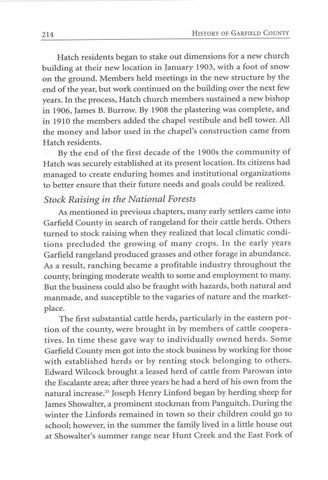214
HISTORY OF GARFIELD COUNTY
Hatch residents began to stake out dimensions for a new church building at their new location in January 1903, with a foot of snow on the ground. Members held meetings in the new structure by the end of the year, but work continued on the building over the next few years. In the process, Hatch church members sustained a new bishop in 1906, James B. Burrow. By 1908 the plastering was complete, and in 1910 the members added the chapel vestibule and bell tower. All the money and labor used in the chapel's construction came from Hatch residents. By the end of the first decade of the 1900s the c o m m u n i t y of Hatch was securely established at its present location. Its citizens had managed to create enduring homes and institutional organizations to better ensure that their future needs and goals could be realized.
Stock Raising in the National Forests As mentioned in previous chapters, many early settlers came into Garfield County in search of rangeland for their cattle herds. Others turned to stock raising when they realized that local climatic conditions precluded the growing of m a n y crops. In the early years Garfield rangeland produced grasses and other forage in abundance. As a result, ranching became a profitable industry throughout the county, bringing moderate wealth to some and employment to many. But the business could also be fraught with hazards, both natural and manmade, and susceptible to the vagaries of nature and the marketplace. The first substantial cattle herds, particularly in the eastern portion of the county, were brought in by members of cattle cooperatives. In time these gave way to individually owned herds. Some Garfield County men got into the stock business by working for those with established herds or by renting stock belonging to others. Edward Wilcock brought a leased herd of cattle from Parowan into the Escalante area; after three years he had a herd of his own from the natural increase. 25 Joseph Henry Linford began by herding sheep for James Showalter, a prominent stockman from Panguitch. During the winter the Linfords remained in town so their children could go to school; however, in the summer the family lived in a little house out at Showalter's summer range near Hunt Creek and the East Fork of


















